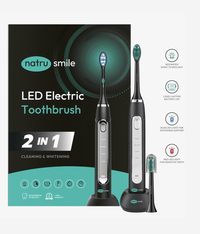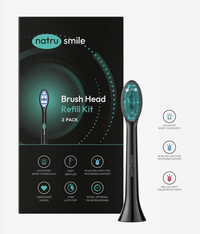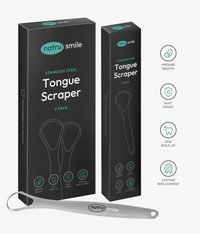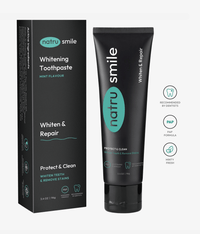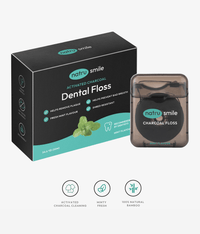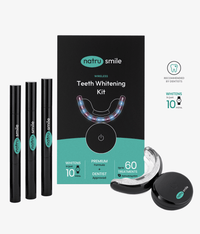
All products are certified by dental expert Dr. Greg Grillo
Crowns are like the “tiara” of your teeth! While they may not be sparkling and flashy, crowns serve a very important purpose. Not only do they protect damaged or decayed teeth when fillings can’t do the job, but they also improve your smile.
While you may be tempted to go with a bright and bold hue, you’ll want to select one that is flattering and fits in with the rest of your smile. After all, your natural tooth color is unique, so finding something that complements it can make all the difference when achieving an aesthetically pleasing look.
In this guide, we’ll explore how to choose the best color for dental crowns so that you can feel confident in your smile.
What Are Crowns Made Of?
There are different types of dental crowns: metal, porcelain, resin, and ceramic.
When you get a crown, your dentist will create an impression of your tooth that is then sent to the lab for fabrication. The lab technicians will use this impression to create a crown that fits perfectly over the affected tooth. From there, they’ll also recommend the proper color and shade for the new crown.
- Metal: Metal crowns are strong and durable, but they’re not the most aesthetically pleasing. These types of crowns are usually reserved for molars since they don’t show as much when you smile.
- Porcelain: Porcelain is a popular material for dentists to use because it looks very natural and is highly resistant to staining. It also provides good coverage over the tooth, so your new crown will blend in nicely with the rest of your smile.
- Resin: Resin is a great option if you’re looking for a budget-friendly crown. It’s also very durable and can be customized to match the color of your teeth. However, it does have some drawbacks, such as being more prone to staining than other materials.
- Ceramic: Ceramic is another popular choice because it looks just like real tooth enamel and comes in many different shades. Plus, ceramic crowns are very strong and can last for many years.
While you may experience some tooth crown pain for a few days up to a week after the procedure, crowns are considered a long-term solution that can last up to 15 years with proper care.
How To Choose The Right Shade For Your Dental Crown
When it comes to crowns, you want something that looks and feels natural. To achieve this, you’ll need to find a color that closely matches your existing tooth shade. If your dentist doesn’t have enough information on the exact hue of your teeth, they might recommend taking an impression or using a dental crown color chart to help determine the right color.
Once you have an idea of what color would look best with your smile, then you can start looking at options. There is a plethora of dental crown colors, so you should have no problem finding one that closely resembles your natural tooth color.
For those receiving a temporary crown, you can select a trial color to give you a better idea of how the final crown will look and feel.
As well, there are a couple of things that can guide you in choosing the right shade:
Skin Tone And Complexion
The hue of your skin can also play a role in what color crown looks best on you. For instance, if you have fair skin, then a lighter shade may look better than a darker one. Likewise, those with darker complexions may benefit from going with a deeper shade to ensure the crown stands out against their skin tone.
Going further, an olive complexion might be complemented by a more yellow tone, while someone with pink undertones could opt for a color that’s slightly warmer.
Your Age
If you’re over 40, then you may want to go with a warmer hue to conceal some of the discoloration that comes naturally with age. Because the enamel gets thinner over time, the yellow dentin underneath will be more exposed. So, if you’re looking for a natural appearance, you won’t want to have a glaringly white tooth.
Natural Teeth Color
If your teeth aren’t stained from food, drink, or tobacco use, then you can just choose a color that is the same as the shade of your natural teeth. This will ensure that your crown looks like part of your smile and not something foreign.
But if you’re planning to get a teeth whitening procedure beforehand and want your crown to match, then make sure to compare your newly-whitened teeth to the shade guide to find one that will be a good fit.
What Is The Difference Between Dental Crowns And Tooth Bridges?
When it comes to dental crowns vs tooth bridges, a dental crown is a cap-like structure that covers the entire visible part of a damaged or decayed tooth. It protects it from further damage and restores its natural shape, size, and appearance.
A tooth bridge is an artificial replacement for missing teeth. Unlike a crown, it does not cover the entire visible portion of the existing tooth; instead, it bridges the gap between two healthy teeth.
What Color Should My Crowns Be?
The color of your crowns should be determined by what looks best with your existing teeth. Generally, it's best to go with a shade that is slightly lighter than your natural tooth color, as this will blend better and look more natural.
Keep in mind that if you have any discoloration or staining on your teeth, the crown color may need to be modified accordingly. For example, if you have yellowish-brown stains on your teeth, then the crown should be a lighter yellow/brown shade. This will help to blend the crown in with your other teeth and create an even, natural look.
Can You Change The Color Of A Dental Crown?
Yes, you can change a dental crown color if it’s not quite what you were expecting. However, this is best done by an experienced cosmetic dentist, as any changes to the crown could potentially weaken its structure or cause further damage. If you do decide to get the color changed, make sure that your dentist uses a special bonding agent for re-cementing the new crown so that it remains secure and in place.
Are Dental Crowns Tooth Colored?
Many dental crowns are tooth colored, but this doesn’t mean that they all match your existing teeth perfectly. As mentioned before, you should use a shade guide or take an impression to help determine the right color for your crown.
Some dental crowns are made with metal and porcelain fused together, which can create a grayish hue rather than one that blends in with the rest of your smile. In this case, you may want to go with a crown that is all porcelain or ceramic.
How Long Do Crowns Stay White?
Your crowns should remain bright and white for around five to seven years with proper care. To keep them looking their best, you’ll want to follow a good oral hygiene regimen which includes brushing twice a day, flossing daily, and using an antiseptic mouthwash regularly. Another good tip is avoiding staining foods and beverages like coffee, tea, or red wine, as this can cause discoloration of the crowns over time.
Is B1 Too White For A Crown?
When it comes to crowns, B1 is often considered too white. This can create a stark contrast between your natural teeth and the crown, making them look unnatural. If you want something that looks more realistic, then it's best to go with a lighter shade that still complements your existing tooth color.
However, if you’ve recently had a teeth whitening treatment, then B1 might be the right shade for you. Talk to your dentist about this option, and they can advise whether it’s suitable.
Can You Make Crowns Whiter?
Unfortunately, crowns are not able to be whitened in the same way as natural teeth. This is because they are made from a material that does not respond to bleaching agents or other teeth-whitening methods. Luckily, there are some dentists who may be able to alter the color of a crown by adding certain chemicals or dyes.
Do All Crowns Turn Black?
No, not all crowns turn black. The majority of crowns are made from either porcelain or ceramic, and these materials don’t typically change color over time.
It’s possible for the material to become discolored if you don’t take proper care of your teeth. That being said, you should still be sure to brush and floss regularly to help to keep your dental work looking its best.
Are Dental Crowns White Or Silver?
The most common color for dental crowns is porcelain, which can range from white to off-white in hue. Some people might still choose silver or gold crowns, as they’re typically used as accents on certain teeth or in the back of the mouth.
If you’re looking for something more subtle or natural, then opt for a classic white/ivory shade of porcelain to blend in better with your other teeth.
What Do I Do If My Crown Is Too White?
If you find that your crown is too white for your liking, there are a few things you can do. First, speak to your dentist about the issue and see what they suggest.
In some cases, the crown may be able to be slightly modified by adding a glaze or tinting it with a different color. If this isn’t possible, then you may need to replace the crown with one in a better shade. While this will require more time and money, it’s worth it if you want the best possible look.
Do Permanent Crowns Look Natural?
Yes! Permanent crowns can look very natural and blend in nicely with the rest of your teeth. This is because dentists use porcelain materials to make the permanent crown, which resembles your tooth’s enamel. Plus, most crowns are custom-made to fit your exact measurements and tooth shape, so they’ll feel just like a part of you.
Do Crowns Turn Yellow Over Time?
Crowns can turn yellow over time, but they aren’t as prone to staining as natural teeth. This is because they are made from materials that are resistant to staining and discoloration. Despite this, they may still become slightly yellowed with age or if they come into contact with certain foods or drinks.
To help prevent this from happening, you should pay close attention to your oral hygiene routine and avoid foods that may stain your teeth (such as coffee or tea). You should also have regular check-ups with your dentist so they can monitor the condition of your crowns.
Conclusion
Selecting the right crown color is an important part of achieving a beautiful, natural-looking smile. To make sure you get the most out of your crowns, choose a color that closely matches your existing tooth shade. If you’re unsure what would look best with your teeth, consult with your dentist for advice on choosing the perfect hue. With the right crown color, you can enjoy a stunning and confident smile for years to come.


